|
|
Guitar Town - tablature
 Songs: Songs:
Guitar
Town (Steve Earle) —
6-string bass part for regular guitar
Guitar Town
(Steve Earle) — 6-string bass
part
My
Old Friend The Blues (Steve Earle) —
acoustic guitar part
My Old
Friend The Blues (Steve Earle) —
electric guitar solo
Someday
(Steve Earle) — rhythm guitar
part followed by lead guitar part
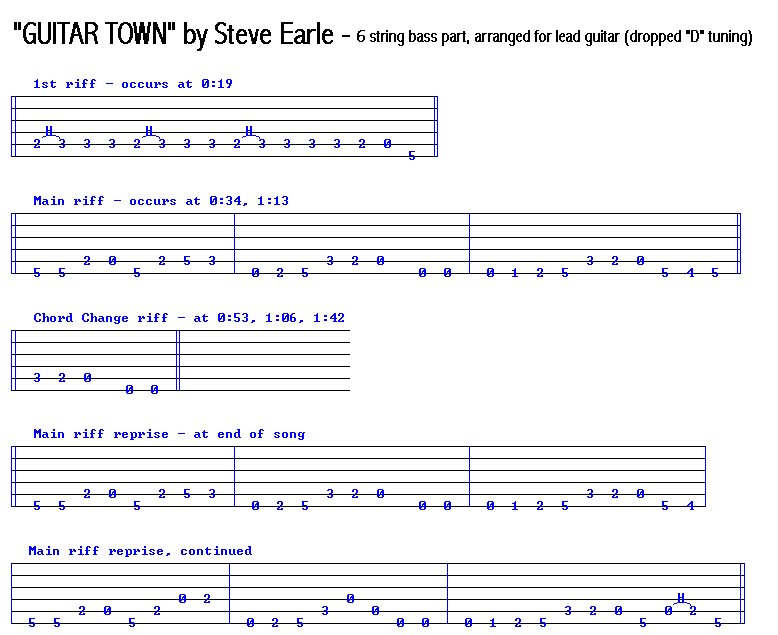
This Tab is for the 6 string bass
part, arranged for lead guitar in dropped "D" tuning.
This is my attempt at transposing the 6
string bass part for "Guitar Town" onto regular electric guitar. If you
don't know what a 6 string bass is, see the notes for the transcription
of this song for 6 string bass, also at this Web site. Except for the dropped
"D" tuning, this is standard Tab, with the lowest sounding (thickest) string,
the low "E" string, appearing on the bottom of the Tab.
Since many people don't have a 6 string
bass floating around, yet still want to be able to play "Guitar Town",
and since I've gotten some requests for this, I Tabbed this part out. Note
that you will need to put your guitar into "dropped 'D' tuning". To do
this, lower the pitch of the low "E" string until it sounds like the "D"
(or 4th) string, only an octave lower. Alternately, you can match the Harmonic
at the 12th fret of the low "E" string to the sound of the open "D" string.
Now you're ready to attack the part!!
This part is pretty straightforward to
play, once you're in dropped "D" tuning. Just remember that all the notes
on the low "E" string have to be fretted up 2 frets from normal - i.e.
the "G" note will now be played on the 5th fret instead of the 3rd. The
best way to play the part is to anchor your index finger at the second
fret, and play all the notes that occur at the 5th fret using your left
hand pinky. For the riffs that go open string->1st fret->2nd fret, you'll
need to use your index finger, sliding up to play the 2nd fret. If you
don't use your left hand pinky much, this song will give it a bit of a
workout!! You really should use your pinky, so don't try to cheat.
The song is almost impossible to play smoothly without using your pinky,
anyway, so don't fight it! *grin*
One last point - as with any 6 string bass
part you're trying to play on regular guitar, use the bridge pickup and
pick hard, as close to the bridge as possible. If you've got a guitar with
single coil pickups, especially a Telecaster, or a Strat, use it!! Actually,
this advice applies to just about any country lead part.
Well, that should do it for this song.
If you have any questions, you can e-mail me at either:
acushen@aol.com
(Andrew Cushen) http://users.aol.com/slideking/
Have fun with the part!!
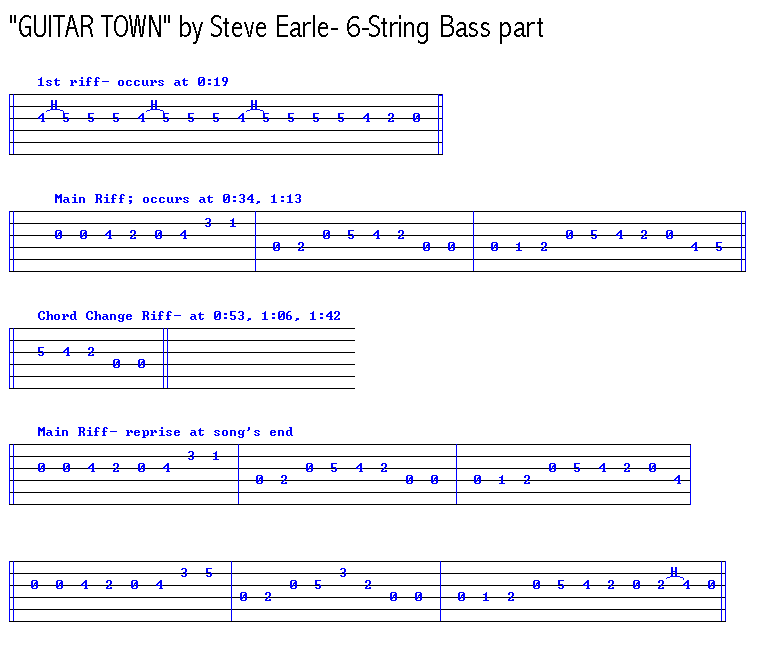
This Tab is for the 6-String Bass
part of "Guitar Town".
It's standard Tab, with the lowest-pitched
string at the bottom of the tab. Note that it is not the regular
electric bass part.
For those of you who may not know, a 6-string
bass is actually a kind of baritone guitar. It is tuned like a regular
guitar, only an octave lower- and, consequently, with much heavier strings
that approach the size of (regular) bass strings. All strings are wound.
These instruments have been around since
at least the early sixties, and were made by several companies, including
Fender. The best known ones, however, were made by Danelectro. Nowadays,
you can buy excellent copies of the Danelectros, made by Jerry Jones of
Nashville.
6-string basses were used most often in
Nashville, on country records - some versions of George Jones' "The Race
is On" and "Do What You Think's Best" have excellent 6-string bass solos.
The players would double the regular bass line, and/or play lead lines.
You can hear Aerosmith's Joe Perry playing the main riff from "Back in
the Saddle" on a 6-string bass. More recently, you can hear Pete Anderson
playing one for the solo on Dwight Yoakam's "Little Ways." There's another
nice 6-string bass part on Dwight's "Buenas Noches (from a Lonely Room),"
as well as several other Yoakam cuts.
Due to the similarity in tuning, it's possible
to play this part on a regular guitar, though it won't sound the same.
One solution might be to detune the low "E" string to D and transpose the
riffs to the lower octave. At any rate, whether playing the part on a 6-string
bass or "faking it" on a regular guitar, the key is to play on the low
strings as much as possible, and pick down near the bridge, with a trebly
tone. Have fun!!
acushen@aol.com
(Andrew Cushen) http://users.aol.com/slideking/
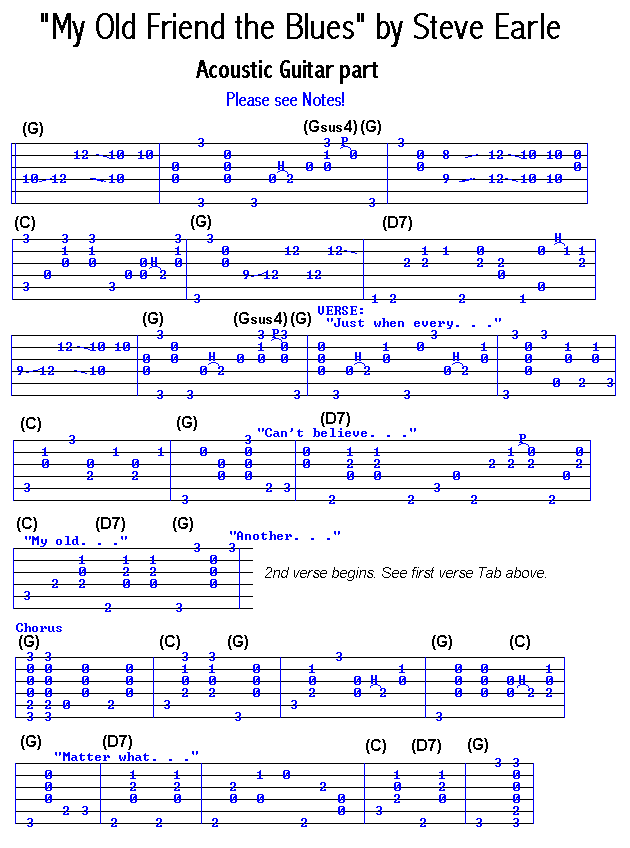
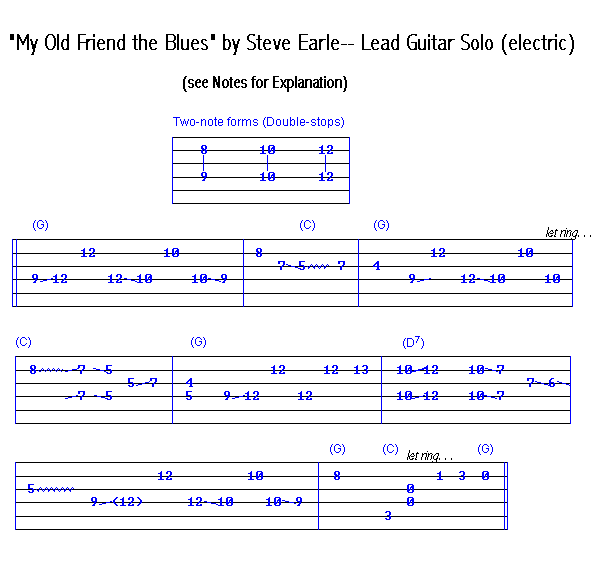
Notes on the Tablature for "My
Old Friend the Blues" by Steve Earle:
This is the Acoustic Guitar Part, and the
Electric Guitar Solo, for "My Old Friend The Blues" by Steve Earle.
This was one of the more challenging songs
to figure out, as Steve uses some unorthodox chord forms (big surprise!)
:-)
The Acoustic part Tabbed here is the part
Steve plays on the record & Live, so it will stand up when played by
itself -- without a band, that is. I have Tabbed out the first Verse
and the first Chorus; these parts don't change that much through the rest
of the song. Some of this Tab may not be 100% correct; the mix on
the record is such that the voice drowns out the acoustic guitar at times,
and I did the best I could.
Some things to remember for the Acoustic
Part:
* This song uses
a combination of fingerpicking and strumming. You may want to try
Hybrid picking (where you use the pick with one or two fingers) for the
fingerpicked parts, then strum with the pick. The parts that are
strummed are the partial chords with pull-offs. If you use a fingerpicking
approach, strum those parts with a fingernail.
* On the D7 chords, I suggest
fingering the notes on the 2nd fret of the 6th string with your left
hand thumb -- it's a bit unorthodox, but it works, and I suspect that's
how Steve does it.
* The 2 note slides (aka
double-stop slides) --you should finger both notes & hold them down
through the slide, even when they're not picked. See the fingerings
at the top of the Tab.
* The Chorus was especially
difficult to figure out, since the rest of the instruments kinda cover
up Steve's playing. Therefore, the Chorus part is approximate and
should be used as a guide only.
Notes on the Solo:
As usual, play this part on a
single-coil electric, like a Telecaster or a Strat, with plenty of Reverb
& Treble. Also, at various parts during the solo, you can hear
some subtle Amp Tremolo on the electric. This is another common feature
of Country Lead guitar parts. The solo can be played without it,
but if you have Tremelo on your Amp, definitely use it! Nowadays, you can
find effects pedals that do a good job of imitating the sound. The
most important part of playing this lead is to understand the fingering
for the two-note, or double-stop, forms. These are the ones up around
the 9th to 12th frets that are slid up & down. The key is to
finger both notes even when you don't pick them, so that you hear your
fingers sliding on both notes. I've included these forms at the top
of the Tab. I finger them like this: the 8/9 -- index finger
on the high note (8th fret), 2nd (middle) finger on the low note (9th fret).
The 10/10 and 12/12 -- 3rd finger on the high note, 2nd finger on the low
note. This allows you to slide from one fingering to the other, though
you'll need to hammer on with the 3rd finger when sliding from the 8/9
to the 12/12.
Have fun!!
acushen@aol.com
(Andrew Cushen) http://users.aol.com/slideking/
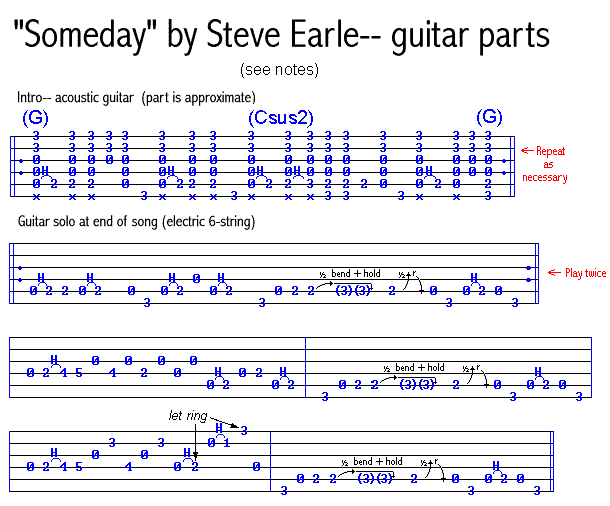
Notes on the Tablature for "Someday"
by Steve Earle:
First up in the Tab is the acoustic rhythm
guitar part. This part uses one of Steve's favorite devices:
holding down an open chord, then alternating between strumming it and picking
a melody on the low (bass) strings. Compare this with the Mandolin
part for "Copperhead Road" (available elsewhere at this web site), or listen
to the guitar on "I Ain't Ever Satisfied".
Also, compare this part with the chords
for this song, in the "Chords" section of this web site. You'll see
that, where the rest of the band plays a C and then a D chord, Steve just
plays a Csus2 chord -- the same chord he uses in "I Ain't Ever Satisfied".
So the band changes from C to D, but Steve doesn't. It works musically
because Steve is playing single melody notes over the D chord.
I've noted that this part is approximate:
this is because Steve plays it slightly differently each time through,
and drops out some of the melody notes during his singing.
This part will take you through each of
the verses and the guitar solo at the end; the chorus is straight open
chords: Em, C, D, and G 4 times, then G D C D 2 times. See
the "Chords" section of this Web site if you need help with which chord
goes where.
The next part of the Tab is the lead guitar
solo at the end of the song. It's relatively straightforward; the
only unusual part is the sustained, or held, bends. These are noted
in the Tab with the arrows; be sure to release the bend right where the
arrow finally points downward, before you pick the next note and bend again.
Each bend in the lead is a half-step; that is, bend the string the distance
of one fret. Make sure you practice getting these bends in tune,
these aren't blues bends, where the pitch you bend to isn't exact.
If you have trouble getting them in tune, first play the note one fret
above to hear the pitch you're aiming for; then go back and try to bend
up just enough to match the pitch of the note on the fret above.
For the first of the two hammer-ons near
the end of the solo in the next to last bar (the hammer-on to the 2nd fret
of the D string), keep your finger down until it's time to pull off from
that note. Let it ring out to get the exact sound of the record.
One final note: on the last one of
each group of hammer-ons to the 2nd fret of the "A" string, you might want
to add a little trill after you hit the note. Listen to the record
& you'll hear what I mean.
(A trill is when you rapidly and repeatedly
hammer-on & pull off between two notes. Do this as fast as you
can between the open A string and the 2nd fret of the A string.)
Remember, this is optional -- if you can't do it smoothly, or aren't sure
what I mean, just leave the trills out!
Again, like 90% of all country leads, use
a Telecaster or other single-coil guitar, use the bridge pickup, and turn
up the treble & reverb on your amp.
Have fun!!
acushen@aol.com
(Andrew Cushen) http://users.aol.com/slideking/
|
|


![]()
![]() Lisa
Kemper
– All Rights Reserved
Lisa
Kemper
– All Rights Reserved
![]()